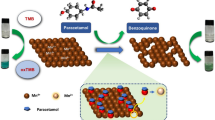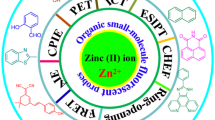Abstract
In this study, a novel tetrapyrazinoporphyrazine-based fluorescent sensor for Cu2+ ion was synthesized and fully characterized by 1H NMR, MALDI-TOF MS, and elemental analysis. A tetrapyrazinoporphyrazine substituent was used as the reporting group and a 2,2′-dipyridylamine moiety was employed as the recognition group. The effects of various metal ions on the absorption and emission spectra of the designed molecule were investigated, demonstrating that this compound shows selectivity and sensitivity toward the Cu2+ ion. Upon addition of Cu2+ ion, a fluorescent intensity of the tetrapyrazinoporphyrazine-based sensor decreased gradually at 655 nm. To confirm a selective binding ability of 2,2′-dipyridylamine moiety toward Cu2+ ion, a comparative study was performed using tetrapyrazinoporphyrazine derivative with bromine instead of 2,2′-dipyridylamine moiety. Furthermore, association constant and detection limit value of the synthesized compound toward Cu2+ ion were derived from a repetitive titration experiment. Also, a reversibility of the prepared sensor was confirmed through additional test using compound and ethylenediaminetetraacetic acid.






Similar content being viewed by others
References
Guo, Y., Zhang, L., Zhang, S., Yang, Y., Chen, X., Zhang, M.: Fluorescent carbon nanoparticles for the fluorescent detection of metal ions. Biosens. Bioelectron. 63, 61–71 (2015). doi:10.1016/j.bios.2014.07.018
Rahman, M.M., Alamry, K.A., Saleh, T.S., Asiri, A.M.: Sensitive and selective Cu2+ sensor based on 4-(3-(thiophen-2-yl)-9H-carbazol-9-yl)benzaldehyde (TPCBZ) conjugated copper-complex. J. Organomet. Chem. 817, 43–49 (2016). doi:10.1016/j.jorganchem.2016.05.013
Liu, J., Lu, Y.: Colorimetric Cu2+ detection with a ligation DNAzyme and nanoparticles. Chem. Commun. 46, 4872–4874 (2007). doi:10.1039/b712421j
Yin, S., Leen, V., Van Snick, S., Boens, N., Dehaen, W.: A highly sensitive, selective, colorimetric and near-infrared fluorescent turn-on chemosensor for Cu2+ based on BODIPY. Chem. Commun.. 46(34), 6329–6331 (2010). doi:10.1039/c0cc01772h
Jung, H.S., Kwon, P.S., Lee, J.W., Kim, J.I., Hong, C.S., Kim, J.W., Yan, S., Lee, J.Y., Lee, J.H., Joo, T., Kim, J.S.: Coumarin-derived Cu2+-selective fluorescence sensor: synthesis, mechanisms, and applications in living cells. J. Am. Chem. Soc. 131, 2008–2012 (2008)
Yu, M.-M., Li, Z.-X., Wei, L.-H., Wei, D.-H., Tang, M.-S: A 1,8-Naphthyridine-based fluorescent chemodosimeter for the rapid detection of Zn2+ and Cu2+. Org. Lett. 10(22), 5115–5118 (2008). doi:10.1021/ol8018192
Li, Y., Zhang, X., Zhu, B., Xue, J., Zhu, Z., Tan, W.: A simple but highly sensitive and selective colorimetric and fluorescent probe for Cu2+ in aqueous media. Analyst. 136(6), 1124–1128 (2011). doi:10.1039/c0an00682c
Maity, D., Kumar, V., T: Govindaraju: reactive probes for ratiometric detection of Co2+ and Cu2+ based on excited-state intramolecular proton transfer mechanism. Org Lett. 14(23), 6008–6011 (2012)
Ghosh, S., Ganguly, A., Bhattacharyya, A., Alam, M.A., Guchhait, N.: Selective chromo-fluorogenic molecular sensor for dual channel recognition of Cu2+ and F–: effect of functional group on selectivity. RSC Adv. 6(72), 67693–67700 (2016). doi:10.1039/c6ra09877k
Durmuş, M., Yeşilot, S., Ahsen, V.: Separation and mesogenic properties of tetraalkoxy-substituted phthalocyanine isomers. New J. Chem. 30(5), 675–678 (2006). doi:10.1039/b600196c
Lekitima, J.N., Ozoemena, K.I., Jafta, C.J., Kobayashi, N., Song, Y., Tong, D., Chen, S., Oyama, M.: High-performance aqueous asymmetric electrochemical capacitors based on graphene oxide/cobalt(ii)-tetrapyrazinoporphyrazine hybrids. J. Mater. Chem. A 1(8), 2821 (2013). doi:10.1039/c2ta01325h
Zarate, X., Schott, E., Gomez, T., Arratia-Perez, R.: Theoretical study of sensitizer candidates for dye-sensitized solar cells: peripheral substituted dizinc pyrazinoporphyrazine-phthalocyanine complexes. J. Phys. Chem. A. 117(2), 430–438 (2013). doi:10.1021/jp3067316
Park, J.M., Song, C.J., Yao, W., Jung, C.Y., Hyun, I.H., Seong, D.H., Jaung, J.Y.: Synthesis of carbohydrate-conjugated azaphthalocyanine complexes for PDT. Tetrahedron Lett. 56(35), 4967–4970 (2015). doi:10.1016/j.tetlet.2015.05.065
Hilderbrand, S.A., Weissleder, R.: Near-infrared fluorescence: application to in vivo molecular imaging. Curr. Opin. Chem. Biol. 14(1), 71–79 (2010). doi:10.1016/j.cbpa.2009.09.029
Kobayashi, H., Ogawa, M., Alford, R., Choyke, P.L., Urano, Y.: New strategies for fluorescent probe design in medical diagnostic imaging. Chem. Rev. 110, 2620–2640 (2010). doi:10.1021/cr900263j
Reid, C.M., Ebikeme, C., Barrett, M.P., Patzewitz, E.M., Muller, S., Robins, D.J., Sutherland, A.: Synthesis and anti-protozoal activity of C2-substituted polyazamacrocycles. Bioorg. Med. Chem. Lett. 18(7), 2455–2458 (2008). doi:10.1016/j.bmcl.2008.02.037
Yao, W., Song, C.J., Park, J.M., Jung, C.Y., Hyun, I.H., Seong, D.H., Jaung, J.Y.: Synthesis of A3B-type quinoxaline-substituted porphyrin photosensitizer. Bull. Korean Chem. Soc. 37(2), 119–120 (2016). doi:10.1002/bkcs.10644
Zha, Q., Ding, C., Rui, X., Xie, Y.: A novel porphyrin-based ligand containing four 4,4′-dipyridylamine moieties: syntheses, structures, and luminescent properties of Mn(II), Cu(II), Zn(II), and Cd(II) coordination polymers. Cryst. Growth Des. 13(10), 4583–4590 (2013). doi:10.1021/cg4011289
Ramos, A.A., Nascimento, F.B., de Souza, T.F., Omori, A.T., Manieri, T.M., Cerchiaro, G., Ribeiro, A.O.: Photochemical and photophysical properties of phthalocyanines modified with optically active alcohols. Molecules 20(8), 13575–13590 (2015). doi:10.3390/molecules200813575
Saka, E.T., Göl, C., Durmuş, M., Kantekin, H., Bıyıklıoğlu, Z.: Photophysical, photochemical and aggregation behavior of novel peripherally tetra-substituted phthalocyanine derivatives. J. Photochem. Photobiol. A 241, 67–78 (2012). doi:10.1016/j.jphotochem.2012.05.023
Liu, H.-h., Chen, Y.: A bifunctional metal probe with independent signal outputs and regulable detection limits. Eur. J. Org. Chem. 2009(30), 5261–5265 (2009). doi:10.1002/ejoc.200900582
Ashokkumar, P., Ramakrishnan, V.T., Ramamurthy, P.: Photoinduced electron transfer (PET) based Zn2+ fluorescent probe: transformation of turn-on sensors into ratiometric ones with dual emission in acetonitrile. J. Phys. Chem. A 115(50), 14292–14299 (2011). doi:10.1021/jp209061f
Xie, Y., Ding, Y., Li, X., Wang, C., Hill, J.P., Ariga, K., Zhang, W., Zhu, W.: Selective, sensitive and reversible “turn-on” fluorescent cyanide probes based on 2,2′-dipyridylaminoanthracene-Cu2+ ensembles. Chem. Commun. 48(94), 11513–11515 (2012). doi:10.1039/c2cc36140j
Lee, H.G., Kim, K.B., Park, G.J., Na, Y.J., Jo, H.Y., Lee, S.A., Kim, C.: An anthracene-based fluorescent sensor for sequential detection of zinc and copper ions. Inorg. Chem. Commun. 39, 61–65 (2014). doi:10.1016/j.inoche.2013.10.049
Kumawat, L.K., Mergu, N., Singh, A.K., Gupta, V.K.: A novel optical sensor for copper ions based on phthalocyanine tetrasulfonic acid. Sens. Actuators B 212, 389–394 (2015). doi:10.1016/j.snb.2015.02.027
Acknowledgements
This work was supported by the Technology Innovation Program (No. 10047756, Development of tetra-pyrrole type for Color, light-emitting, detecting Devices) funded by the Ministry of Trade, Industry & Energy (MI, Korea).
Author information
Authors and Affiliations
Corresponding author
Electronic supplementary material
Below is the link to the electronic supplementary material.
Rights and permissions
About this article
Cite this article
Jung, C.Y., Yao, W., Park, J.M. et al. Synthesis of a tetrapyrazinoporphyrazine-based fluorescent sensor for detection of Cu2+ ion. J Incl Phenom Macrocycl Chem 89, 85–90 (2017). https://doi.org/10.1007/s10847-017-0735-3
Received:
Accepted:
Published:
Issue Date:
DOI: https://doi.org/10.1007/s10847-017-0735-3




